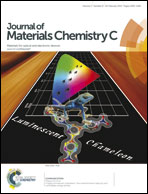Utilization of “thiol–ene” photo cross-linkable hole-transporting polymers for solution-processed multilayer organic light-emitting diodes†
Abstract
Solution-processable hole-transporting layers (HTLs) capable of cross-linking are especially important in solution-processed organic light-emitting diodes (OLEDs) to achieve multilayer structures with separated charge-transporting layers and emitting layers. In this work, we report the first example of photo cross-linked HTL adopting “thiol–ene” reaction. A new allyl-containing hole-transporting polymer, Allyl-TFB, has been synthesized and characterized by NMR, TGA, DSC, UV-vis spectroscopy, cyclic voltammetry, etc. The allyl ether moiety successfully participated in thiol–ene photo cross-linking to give cross-linked HTL. The solvent resistance of the cross-linked Allyl-TFB film was evaluated by changing the UV irradiation time from 5 to 240 seconds. In addition to cross-linking, fine patterning of Allyl-TFB with a photo-mask was also demonstrated. To ascertain the usefulness of our new photo cross-linkable HTL system in phosphorescent OLEDs, OLED devices with the configuration of [ITO/PEDOT:PSS/(Allyl-TFB)/26DCzPPy:Ir(mppy)3/TPBi/CsF/Al] were fabricated. There were large differences in device characteristics depending upon the UV irradiation time of HTL, that is to say, the less UV irradiated (30 s) device, Device-1, showed lower operating voltage and higher efficiency than the more UV irradiated (180 s) one, Device-2. This difference in device characteristics originated from the difference in hole-transporting property with UV irradiation time, which was confirmed by hole-only device characterization. Device-1 also showed a better performance than the control device containing no HTL or simple TFB. The maximum luminous efficiency and power efficiency of Device-1 adopting our new cross-linked Allyl-TFB HTL were 31.4 cd A−1 and 21.8 lm W−1, respectively. Based on these results, we expect that this type of thiol–ene photo cross-linking will find various applications in cross-linking and patterning of active organic electronic materials as well as OLED materials.


 Please wait while we load your content...
Please wait while we load your content...